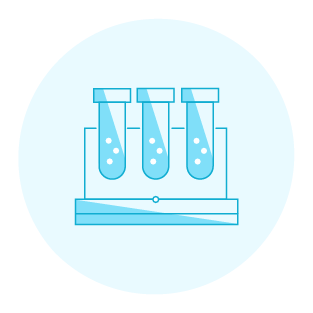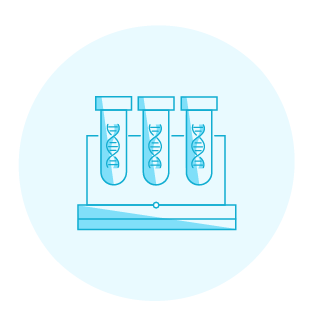What is Cardiogenetics?

Heart disorders are passed on through generations, affecting people at any age and can be life-threatening. These heart disorders are genetically heterogeneous and have variable clinical presentations. Pathogenic variant(s) in a single gene may be associated with different cardiac conditions (clinical heterogeneity). In different genes, it may cause a similar cardiac phenotype (genetic heterogeneity). The phenotypes can be inherited in an autosomal dominant, autosomal recessive, or X-linked manner, depending on the specific etiology. Cardiomyopathies can also be inherited in a mitochondrial manner. There is a strong genetic component in many commonly seen cardiac ailments.
Prevalence
- The estimated prevalence of cardiovascular diseases in India is about 10.5% of the population, which is approximately 32 million affected individuals1
- 11% of non-diabetic patients and 21.4% of diabetic patients are at risk of being diagnosed with cardiovascular diseases1,2,3 & 4
- The incidence of cardiac diseases has increased from 2% to 10.5% of the urban population1
- Congenital Heart Disease has an estimated prevalence of 2 to 6 per 1000 live births
- Familial Hypercholesterolemia affects about 1 in 500 people in most countries
- [1] Jayashree S., Arindam M. and Vijay K. V. 2015 Genetic epidemiology of coronary artery disease: an Asian Indian perspective. J. Genet. 94, 539–549
- [2] Mohan V, Deepa R, Rani SS, et al. Prevalence of coronary artery disease and its relationship to lipids in a selected population in South India: The Chennai Urban Population Study (CUPS No. 5). J Am Coll Cardiol 2001;38:682-7. 10.1016/S0735-1097(01)01415-2
- [3] Gupta, Rajeev. “Recent trends in coronary heart disease epidemiology in India.” Indian heart journal 60.2 Suppl B (2008): B4-18.
- [4] Enas, Enas A., and A. Senthilkumar. “Coronary Artery Disease in Asian Indians: An Update and Review.” (2001).

What are the common cardiac diseases that have a genetic component?
- Congenital Heart Disease is the most common type of birth defect, representing an important cause of infant morbidity and mortality
- CHD refers to structural and functional heart defects present during birth, that include septal defects, valve defects, and outflow tract anomalies
- Syndromic CHD can be due aneuploidies, chromosomal deletions or translocations, or single-gene defects
- Cardiac Channelopathies develop as a result of mutations in genes encoding ion channel proteins, involved in cardiac conduction thereby impairing channel function
- Most channelopathies follow an autosomal dominant pattern of inheritance
- Long QT Syndrome is the most common cardiac channelopathy, estimated to affect about 1 in 2500 persons It can be asymptomatic or characterized by symptoms like arrhythmias/heart flutters, syncope/fainting, and sudden cardiac death
- Currently, there are 13 types of LQTS depending on the presence of the mutation along with the various genes
- Majority of LQTS follow the autosomal dominant mode of inheritance
- Short QT Syndrome is inheritable cardiac channelopathy characterized by abnormally short QT intervals and atrial fibrillation in the absence of structural heart disease
- A cardiac arrest is the most frequent symptom (up to 40%), followed by palpitations (30%), syncope (25%), and Atrial Fibrillation (AF)
- Brugada Syndrome is characterized by ST-segment elevation in leads V1–V3 of an electrocardiogram (ECG)
- Sudden cardiac death could be the first manifestation of the disease
- BS can occur from early infancy to late adulthood
- Affected individuals develop monomorphic ventricular tachycardia; often precipitated during sleep or rest, and especially fever
- BS accounts for 4% to 12% of sudden cardiac deaths
- Catecholaminergic Polymorphic Ventricular Tachycardia is a pathological condition whereby intense physical exercise or acute emotional stress can trigger ventricular tachycardia (abnormal heartbeat) which can lead to dizziness, fainting (syncope) and in the worst cases, cardiac arrest and sudden death
- CPVT affected individuals have normal resting EKGs with a structurally and functionally normal heart
- CPVT has an estimated prevalence of 1 in 10,000 people and commonly manifests at an early age
- Cardiomyopathy is a disease of the heart muscle, characterized by an enlarged, thick, or rigid muscle
- Cardiomyopathy can lead to heart failure, arrhythmias, and/or sudden death
- It can also be a symptom of other genetic diseases such as Noonan’s syndrome, Danon disease, Fabry disease, mitochondrial myopathy, or muscular dystrophy
- Hypertrophic Cardiomyopathy is also known as Idiopathic Hypertrophic Subaortic Stenosis (IHSS)
- HCM is characterized by thickening of the left ventricle thereby restricting blood flow through the heart, and for the left ventricle to fully relax
- Children with HCM are also at increased risk for arrhythmia
- Dilated Cardiomyopathy, also known as congestive cardiomyopathy, is a common form of cardiomyopathy in children, and ischemic cardiomyopathy is the most common type of dilated cardiomyopathy
- In DCM, the heart becomes enlarged and does not contract, or squeezes poorly
- In Restrictive Cardiomyopathy, the ventricle cannot relax properly. As a result, blood flows back into the atria, and they become enlarged, while the ventricles remain normal in size
- This is a rare form of cardiomyopathy that can occur anytime from childhood to adulthood
- Arrhythmogenic Right Ventricular Dysplasia is a disorder of the muscular wall of the heart where part of the myocardium breaks down over time, increasing the risk of an abnormal heartbeat (arrhythmia) and sudden death
- It usually appears after 10 years of age
- Left Ventricular Non-compaction is the most recently classified form of cardiomyopathy, characterized by abnormal trabeculations in the left ventricle, most frequently at the apex
- It can be associated with left ventricular dilation, systolic or diastolic dysfunction, or both, or various forms of congenital heart disease
- It is a condition where the muscular wall of the left ventricle appears ‘spongy’
- It can affect the heart’s ability to work efficiently as a pump and affect the electrical signaling of the heart
- Familial Hypercholesterolemia is a genetic condition of the abnormally high level of cholesterol in the blood
- Deposition of cholesterol in the walls of arteries leads to atherosclerosis resulting in coronary artery disease and heart attack
- FH can be transmitted in both autosomal dominant and recessive inheritance patterns
- Inherited forms of hypercholesterolemia resulting from mutations in the LDLR, APOB, or PCSK9 gene have an autosomal dominant pattern
- The mutations in the LDLRAP1 gene cause an autosomal recessive form
Why do you need genetic testing for cardiac diseases?
- A genetic diagnosis can be life-saving as genetic test results can direct and improve patient treatment, management, and target surveillance for cardiovascular complications
- They can help determine if an individual carries a disease-causing variant associated with a heritable risk to develop cardiomyopathy
- This provides valuable information to the patient and their family about future medical management
- Genetic testing can differentiate hereditary cardiomyopathy/channelopathy from other genetic and non-genetic heart conditions
Cardiovascular Pharmacogenomics
- Pharmacogenetics involves applying DNA sequence data to predict drug response, and also to drug discovery and development
- It helps prescribe the right drug and dosage to the patient
- Significant interpatient variability in drug response can be attributed to genetics
- A person’s genotype can influence drug metabolism, drug transport, and sensitivity to a drug
- Sufficient guidelines describing the use of genetic information are now available to guide treatment with these therapies
When do you need to get tested?

- Patients with heart defects present since birth
- Unexplained cardiac arrest or sudden deaths in the family that might have been caused by an undiagnosed heart disease
- Enlarged heart
- Heart failure at less than 60 years of age
- Irregular heartbeat
- Early heart attack, coronary artery disease, or stroke
- Enlarged aorta or aortic aneurysm in the chest at less than 55 years of age
- Sudden infant death syndrome (SIDS) in the family
- High cholesterol level
Who needs to get tested?
- Individuals presenting with symptoms of cardiovascular disease
- Individuals with a family history of CAD or familial hypercholesterolemia or other cardiovascular diseases
- Individuals with high lifestyle risk i.e. with hypertension, diabetes, smoking habits, alcohol consumption, stressful lifestyle, etc
- All individuals above the age of 35 years, with comorbidities like hypertension, diabetes, or elevated blood cholesterols
Why recommend Actia for patients with Cardio Genetics?
Actia offers a broad range of pre-designed gene mutation panels which have been developed with in-depth disease understanding of the genetic disorder incorporating the latest research in that particular domain. New updated technologies, helpful customer service, and clear result interpretation along with counselling sessions with our expert genetic counsellors make us equipped to provide you with the best available support for your patients and families with cardiovascular disease
Actia offers

- Actia Cardiac Channelopathy Panel: Includes sequence analysis of 50 genes that encode myocardial ion channels that regulate cation in influx/efflux, as well as channel-associated regulatory factors and interaction partners.
- Actia Cardiomyopathy Panel: Includes sequence analysis of 154 genes associated with cardiomyopathy that often encode proteins of the sarcomere
- Cardiomyopathy Predisposition Test: An additional testing option available where a 25bp deletion in the MYBPC3 gene is looked into
- Hypercholesterolemia Gene Panel: NGS panel with 23 genes associated with FH
- Clopidogrel dosage CYP2C19*2 & CYP2C19*3
- Statin-induced myopathy predisposition SLCO1B1 p.(Val174Ala) by RT-PCR
- Warfarin dosage-VKORC1 (c.-1639 G>A), CYP2C9*2, CYP2C9*3, CYP2C9*13 by RT-PCR
What are the test methodologies?
- Next-generation Sequencing (NGS) Using genomic DNA extracted from blood, the coding regions of all the genes are captured and sequenced simultaneously by NGS technology on an Illumina platform. The sequence data that is generated is aligned and analyzed for sequence variants.
- Multiplex Ligation-dependent Probe Amplification (MLPA) Deletion and duplication analysis of genomic DNA is carried out by MLPA. This method allows for the amplification of multiple targets with only a single primer pair.
Test sample requirements

Blood (3-5ml in EDTA tubes)
Required forms
- Relevant clinical information including all the clinical presentations and symptoms
- Test request form
Turn around time (TAT)
- 28 days for NGS
- 15 days for MLPA

Extracted DNA samples (1µg high-quality DNA)
FREE GENETIC COUNSELLING
Actia offers all your patients FREE pre & post-test genetic counselling with our expert and certified genetic counsellors. We offer the best available support for your patients and families via
- Latest technologies
- Helpful customer service
- Clear result interpretation
- Counselling sessions with our genetic counsellors


 Enquire
Now
Enquire
Now